The Everest Base Camp trek is one of the best and more rewarding multi-day hikes in the world. If you’re keen to go on this trek, you’ve found the right place. Here we will go through everything you need to know to plan an awesome trip to Everest Base Camp.
Mount Everest is the top of the world. It lures thousands of people every year that come from great distances to climb to its summit. At 29,083 feet (8,867m), it’s the highest place in the world by about 1000 feet. Oxygen levels at the top are about 1/4 of what they are at sea level. I have always wanted to see Everest and bask in its glory. Getting to the top would be the experience of a lifetime.
But alas, I am not crazy. Or rich. Both of which you need to be to conquer Everest. But you don’t have to be crazy to do the epic hike to Everest Base Camp. All you need is a decent level of fitness, a sense of adventure, and a two week vacation.
It’s one of this planet’s ultimate hiking experiences and definitely one of the best treks in Nepal, along with the Annapurna Base Camp trek. I can’t even begin to describe how rewarding it is to complete, or how gorgeous the Himalayan mountain views are every way you look. So read on to see how to plan and complete the trek to Everest Base Camp.
Note: this article contains affiliate links, which means that should you purchase something or get a quote through them I may make a small commission at no additional cost to you. This helps keep the site running with up to date information. I do not represent World Nomads. This is information only and not a recommendation to buy the product mentioned in this article.
The Everest Base Camp Trek – What You Need to Know
Where is Mount Everest?
Mount Everest is on the border of Nepal and Tibet. This post is about the Everest Base Camp trek through Nepal, which is far more popular than the similar hike on the Tibetan side. Everest Base Camp is just south of the border.
How to get to Everest Base Camp
You will be flying into Kathmandu, the capital of Nepal. From there, you’ll take a hopper flight to the mountain village of Lukla (included in your trekking package unless you go without a guide). Once you get off the plane in Lukla it’s all walking from there.
Trekking guides
While not required, my recommendation is to take a guide. If you’re not on a very strict budget this is by far the smartest thing to do. We used Mountain Monarch and were very happy with our choice. More on this later.
Where to stay
On the trail you will stay at guest houses that are referred to as “tea houses”. They are very basic but they get the job done. Your trekking package will include all accommodation. If you’re doing it without a guide, rooms are first come first served. The tea houses are all pretty much the same, but amenities decline the higher up you get.
Once you get past the thriving mountain town of Namche Bazaar you probably won’t find flush toilets or hot showers. Rooms will have twin beds and you’ll have to go into the common areas to get electricity. If you’re more of a luxury traveler, this isn’t the adventure for you.
Everest Base Camp trek trail length
The trail is a total of about 51 km (32 miles) each way, so 102 km round trip (64 miles). With side trips and acclimation days, you’ll cover about 120 km (75 miles) total. There are 11 days of hiking; 8 days to get to Everest Base Camp and 3 days to return to Lukla.
Elevation of Everest Base Camp
At 5363m (17,594 feet), the base of Everest is higher than you can get in most countries. The lowest point of the trek is 2650m (8692 feet) so you are climbing quite a bit high in the Himalayas. Even for people accustomed to hiking high in the Rockies or the Alps, the Himalayas present a new challenge. Anyone who has ever struggled with high elevations should not attempt this trek.
Food along the trail
You will eat at the tea houses, which all have restaurants. The menu at each tea house is essentially the same. You’ll find pastas and rice/noodle dishes as well as more traditional Nepali dal. There are no roads up in the Himalayas and everything must be brought in by foot or by yak.
On top of that not much grows this high up, so fresh food is tough to come by. Refrigeration is limited and nearly everything you eat will be something with a long shelf life. It is recommended that once you pass Namche Bazaar you don’t order any meat, as it will not be fresh. Overall, the food is not great and you’ll be dying for a good meal once you’re back in Kathmandu.
Language
Your guide will speak English. Your porters most likely will not, nor will the people working at the tea houses. They will probably speak Hindi though, so if you have an Indian wife like me there will be no language barrier.
Money
The currency in Nepal is the Nepali rupee. Nepal is a very poor country and thus it is very cheap for travelers. With an organized guide, everything will be prepaid and you’ll only need cash for things like alcohol and internet/electricity.
If you’re on your own you will want to carry plenty of cash. You should also tip your guide and porters in cash, though they’ll happily accept USD or Euros.
Weather and when to do the hike
The weather in the Himalayas varies greatly by season. The time of year you go will be based on the weather. There are two trekking/climbing seasons: fall and spring. It is possible to do it in the winter if you don’t mind blistering cold and snow covered trails.
Going in the summer monsoon season would not be a smart idea (trekking companies don’t offer summer treks). We went in October, which is the peak month for trekking in the Himalayas. We didn’t find it too crowded though. September, November, April, and May are also supposed to be nice.
Mount Everest and the Himalayas
The Himalayas in northern Nepal are mountains on a whole other level. The peaks you’ll see from the trail are thousands of meters higher than anything you’ve seen in a western country. Everest is literally twice as tall as the highest peak in the contiguous US. Yaks roam the valleys and there are dozens of small villages scattered around. It’s utterly gorgeous.
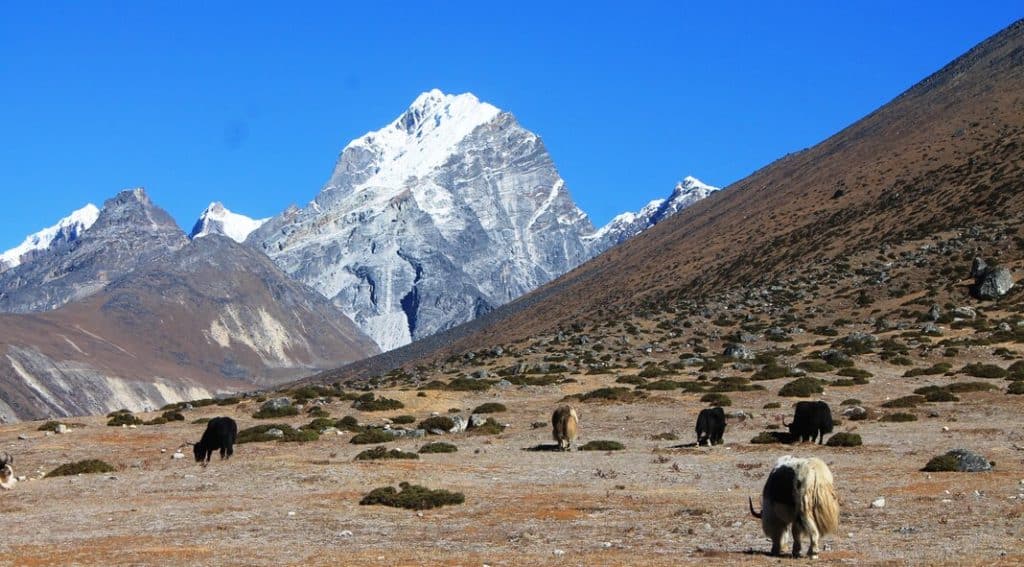
The views along the Everest Base Camp trek are absolutely to die for. Every way you look there is something beautiful. I can’t possibly describe how incredible these mountains are. The pictures I’ve included in this post are my attempt to convey to you just how stunning it was up there.
Love epic hikes? Then check out the Inca Trail to Machu Picchu!
How the villages get by
Life up in the Himalayas is pretty traditional. The buildings are built from locally sourced stone masonry. Everything else has to be brought up the trail from Lukla, the only place with an airport. Yaks carry a lot of the goods, but far more is carried by people.
Mixed in with all the trekkers you will see tons of locals carrying various goods on their backs. The Himalayan native people are incredible. They are tiny, but can carry massive loads on their backs up the mountains. I saw one guy with at least 12 cases of beer on his back, walking like he was on a leisurely stroll through the park.
These days, the economy of the Himalayan villages depends on Everest related tourism. If you’re not on a strict budget, treat yourself to things like beer or candy bars. They are overpriced for sure, but it will help the locals out.
The Lukla Airport
You might have heard that Lukla is the most dangerous airport in the world. It’s hard to argue against that when you land there in person.
The runway is extremely short, sloped, and if your pilot makes just the slightest misjudgment you crash straight into the face of a cliff. Safety has been improving over the years and now with any sort of unfavorable weather planes will not attempt the landing.

Headlines of crashes at Lukla are becoming less frequent. But don’t be fooled, it is still a risky landing. The flight itself is amazing, flying over the Himalayas and such. You’ll get a few minutes of nerves when the plane starts aiming for that runway though!
Choosing a Trekking Guide
There is no shortage of quality trekking outfitters in Nepal. I can strongly recommend the company we used, Mountain Monarch. Their communication is great and their guides are knowledgeable and trained in high altitude first aid. Our guide – whom we are still Facebook friends with – summited Everest a few years after we did the trek. We felt very comfortable with an experienced mountaineer.
The cost for the entire package as of 2023 is $1675 USD per person. When we did it in 2014 it was $1150, so prices are rising steadily. The price includes the guide, two porters to carry your belongings, entrance to Sagarmatha National Park, the flight from Kathmandu to Lukla, 11 nights accommodation in basic tea houses, and three meals per day.
That comes out to about $152/day per person. When thinking about how cheap Nepal is overall, it sounds expensive. But I believe it’s worth it for what you get.
If you go with another outfitter they will offer a similar package with a similar price. Just try to book a local company and not an international conglomerate. With a local Nepalese company, the money will stay within the country, where it is needed.

The benefits of using a guide
While you don’t have to use a guide, I feel you should if you have the money. The main benefits are:
- Experienced local guide: you’re going with a local who speaks English and knows everyone around the villages. The guides will have a lot of information for you, but more importantly will know the mountains intimately.
- Porters: you will get porters to carry your belongings. You are out there for 12 days so you will probably have a fair amount of clothing. They will also carry sleeping bags (to use at the tea houses even though they have beds), a first aid kit, and supplemental oxygen. The oxygen is a huge benefit you won’t get if you’re trekking on your own. Pray you don’t need it, but it’s nice to know it’s an option.
- Advanced bookings: All the tea houses you stay at will be pre-booked and you don’t have to worry about beating the rush and possibly having to hike to the next village. You also won’t have to deal with booking your flight to Lukla.
- Clean water: You shouldn’t drink the water from the streams and rivers running through the mountains. They’ve been contaminated with waste over the years. With an organized tour you will get chilled boiled water each morning.
- Avoid misunderstandings: Having a local with you will bridge any language barrier.
- Peace of mind: This is the biggest benefit in my opinion. Hiking in the Himalayas can be challenging at best and life threatening at worst. People die hiking and climbing these mountains. Being with a seasoned mountain climber trained in survival techniques was very reassuring.
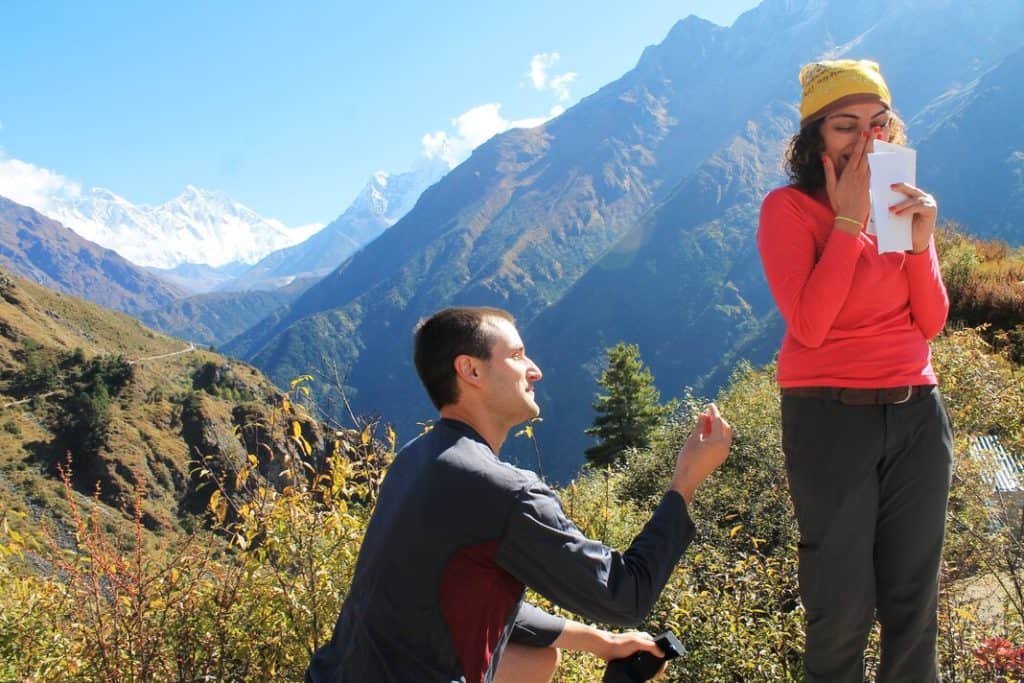
Trekking without a guide
It’s totally possible to do this trek without a guide. The only reason to do this in my opinion is to save money. If you go this route there are many additional things you have to think about.
It’s easy enough to follow the trail, but you’ll have to arrange all your own accommodations and meals, as well as park permits. You’ll need an evacuation plan in case you get altitude sickness or suffer an injury.
If you’re on your own you’ll also have to carry all your own stuff and purify your own water. I don’t care how fit you are, you are going to be exhausted when you’re up at 5000 meters (16,400 ft). I’ve done the Inca Trail to Machu Picchu – which tops out at about 4200m (13800 ft) carrying all my own clothing (porters carried tents and food) and that was difficult enough.
There are many blogs online from people who have done it without a guide so I suggest reading one of these if you think you want to go that route. If you have adequately prepared and have backup accommodation plans and an evacuation plan, you will still have a great time.
Trek Preparation
If you have decided to go on this trip there are a few things you need to do first. This isn’t going to Paris or Rome. This is an intense and potentially dangerous vacation. But it will be one of the most rewarding experiences of your life if you come prepared.
Fitness
You don’t need to be a marathon runner to complete the Everest Base Camp trek, but you will need a decent level of cardiovascular fitness. You will be doing 11 straight days of hiking very high in the mountains climbing a total of over 6,000 meters (20,000 ft).
If you don’t exercise regularly and don’t train at all beforehand, you might make it to base camp, but you will be miserable. The better shape you are in the more you will enjoy the trek. I recommend starting a regular exercise routine at least two months prior to the trek. High intensity interval training (HIIT) or consistent cardio workouts will be best.
If you live somewhere with hills or mountains, do as many practice hikes as you can. If you live somewhere flat, consider using stairs or an inclined treadmill to train. There is really nothing you can do to prepare for the altitude if you live at sea level. Just get into the best shape you can.

Travel insurance
Travel insurance is very important for this trip. If you’ve never used it before, don’t push your luck this time. In fact, many tour operators will require that you have travel insurance to trek with them.
It is also vital that your insurance cover helicopter evacuation up to 6000m in elevation. Many travel insurance plans will not offer this, so be sure to check for it.
World Nomads offers coverage for more than 150 activities as well as emergency medical, lost luggage, trip cancellation and more. You can search for a plan using the link below.
Packing for the trek
You’ll need to prepare for various extremes in weather. At the lowest point of the trek it can be quite hot. At the highest point it can be downright frostbite inducing. On top of whatever you typically hike in – for me that’s just athletic shorts and a T-shirt – here are some things to be sure to pack for the trek:
- Sturdy hiking boots: I hate hiking in boots. I much prefer running shoes. But boots are recommended here. I went with high tops. You do not want to sprain your ankle and ruin your trip.
- Rain poncho: it will rain on you at some point.
- Gloves: both light and heavy.
- Beanie: it’s cold above 5000 meters.
- Sunscreen: a sunburn on the first day could make the rest of the trek painful
- Sunglasses
- Extra battery for camera: if you have one
- Multiple water bottles: remember you will get water in the morning and that will have to last you all day.
- Day pack backpack: while porters will carry your things, they’ll probably be way ahead of you. You’ll still need to carry your own water and snacks and anything else you might need while you’re on the trail.
Friends and family
Be sure that your family and some friends know where you are and what your itinerary is. You will probably be off the grid the majority of the trek so you don’t want anyone worrying about you.
During the last few days of our trek there was a blizzard to the west and 43 people on the Annapurna circuit were killed. Everyone was worried about us for days since we were off the grid. We only heard about it when we got back to Kathmandu. We only had light snow on the Everest base camp trek, thankfully.
Mental preparation
This is not a relaxing vacation. It is an awesome vacation, but there will be times when you are downright miserable. When your head is pounding as you climb stone steps at 5200 meters in the pouring rain you will not be a happy camper. You have to be ready for this.
Everest Base Camp Trek Basics
Here are a few things to know about the trek before we get into the day to day plan.
A typical day on the trek
On a typical day you’ll rise around 7ish and have breakfast at your tea house. You’ll pack your daypack and the porters will grab everything else. The morning hike will be 3-4 hours, mostly uphill, before stopping an hour for lunch.
After lunch you’ll finish your hike for the day, usually arriving at your tea house mid afternoon. There may be monasteries to visit along the way, but either way you’ll have plenty of time to rest and recuperate.
We used the afternoon time to nap before dinner. Dinner is usually around 19:00-20:00 and after this you have more free time. We used almost all of our free time to sleep. It cannot be overstated how important adequate sleep was.
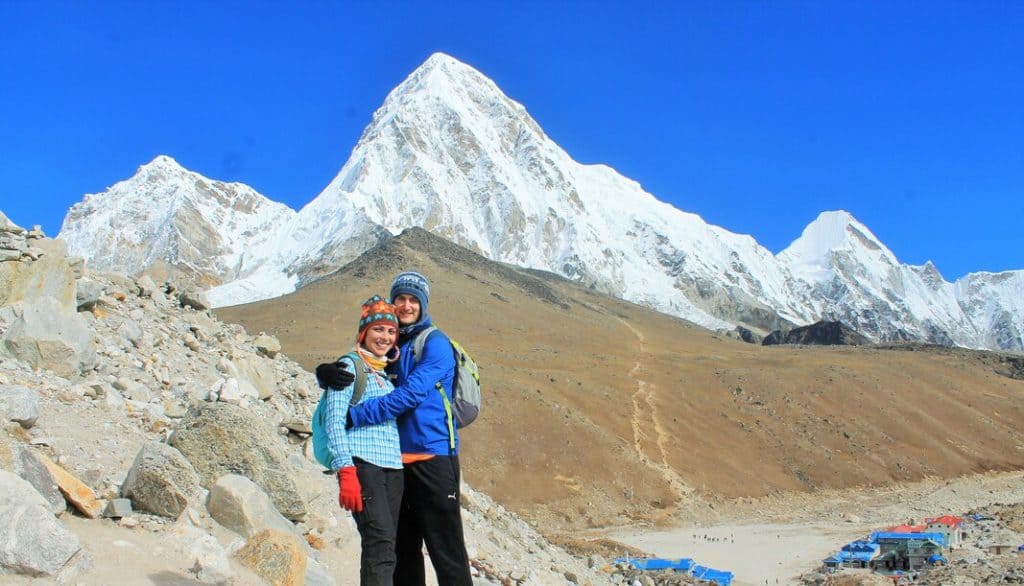
Acclimatization
Two of the days (one at Namche Bazaar and one at Dingboche) will be used for acclimatization. This is vital to an enjoyable trek. Getting too high in elevation too fast can be dangerous and ruin your trip. On acclimatization days you will climb up the trail – usually a different trail – and then back down. It may seem soul crushing to have to climb back down just to go back up again the next day but it’s for your own benefit.
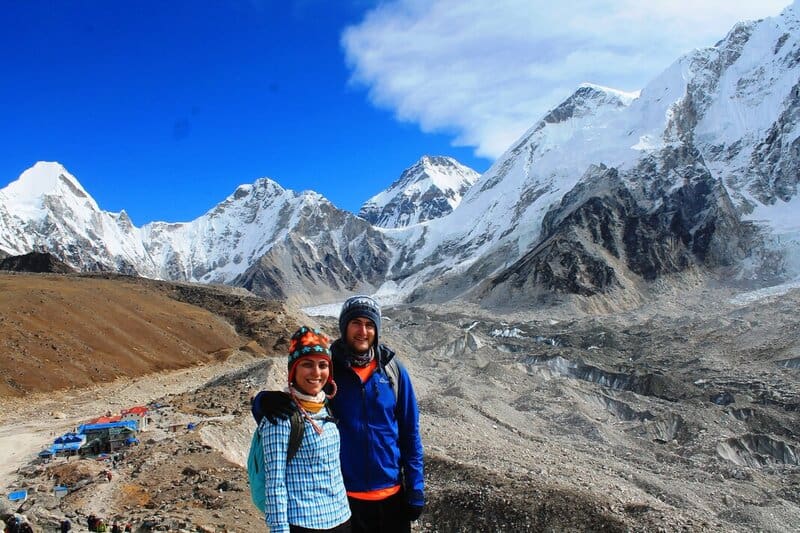
Connectivity
Be ready to disconnect from your life for 11 days. While wifi is available at the tea houses, it’s pricey and often so bad you can’t even load a photo. We only bought it once on my wife’s birthday to share a photo of the birthday cake our guide got for us.
Wifi is better in Namche Bazaar, which is the only stop that can be described as an actual town. We got it on the way up but not the way down. If I did it again I’d go the whole time without internet.
Showers
Also prepare to not bathe for a week. We only showered at Namche Bazaar, both on the way up and the way down. Many tea houses have solar powered hot showers, but they may not be working. Or they may be too busy. Or you may decide after hiking all day that you just want to pass out. Either way, there’s a good chance you’re gonna stink.
The Everest Base Camp Trek Itinerary
We won’t go into great detail here, but here are some of the main highlights of each day on the trail.
Lukla to Namce Bazaar
The first two days will take you from Lukla to the bustling Himalayan town of Namche Bazaar. You’ll actually drop 200m overall in elevation the first day, getting to the lowest point on the trail. The second day is a big climb up nearly 900 meters, taking 6-7 hours. If it’s a clear day you’ll get your first view of Mount Everest through the trees.
Acclimatize at Namche Bazaar
The third day you’ll do a little day hike up to a mountain high above town. There’s a very nice hotel – the Everest View Hotel – up there that you can have a drink at with a lovely view of Everest.
Namche Bazaar itself is actually a decent sized town. It’s quite amazing to see a place like this in the mountains with no connection by road to the outside world. This is the last stop where you can safely have a non-vegetarian dinner.
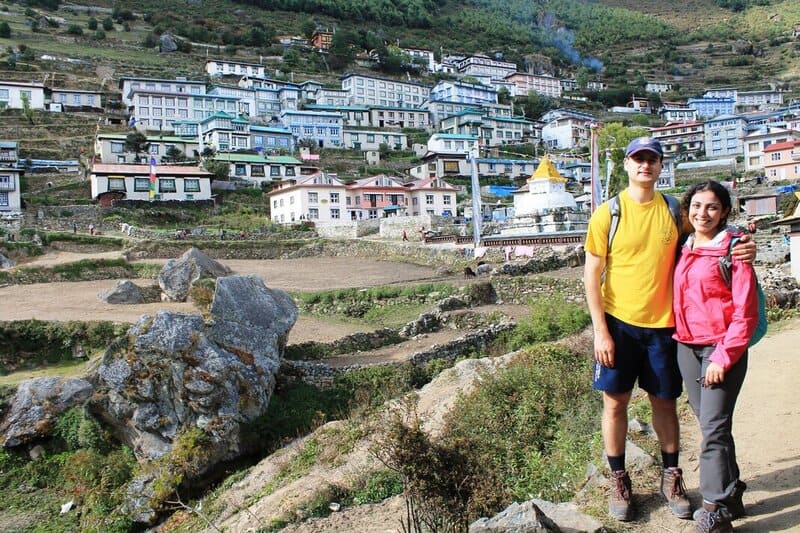
Namche Bazaar to Dingboche
The next two days are a nice hike through the valley up a gradual grade. From Namche Bazaar it’s actually quite a pleasant walk along the side of a mountain as you head towards Tengboche.
It was on this part of the trail that my wife and I got engaged. Once I found a nice view of Everest I dropped down to one knee. There was a crowd of people watching with our guide taking photos, so good thing she said yes!
You’re likely to stop at Tengboche Monastery, one of the most important monasteries in the region for the locals. You’ll spend a night here here then head onwards to Dingboche. As the trail climbs the ridges the trees will start to disappear. The tree line in the Himalayas is much higher than in most mountain ranges. It’s somewhere around 4000m (13,100 ft).
I love the mountains free of trees. I think it’s far more beautiful. From here on out, everywhere you look is just strikingly gorgeous. Dingboche is a nice little village in a lovely location. You’ll spend two nights here at 4360m (14,300 ft).
Acclimatize at Dingboche
You’ll have the option to just take a rest day. But if you really want to prepare for the rest of the trek it’s best to get out and hike up the mountain above Dingboche. You can go as far as you feel comfortable. You’ll have some pretty great views of the valley and the surrounding peaks from up there.

Hiking up and down helps with acclimatization more than just rest. From here on out you are going to start feeling that altitude. I don’t care how many Colorado 14ers you’ve hiked. You’re now significantly higher than anywhere in Colorado.
I generally felt pretty good until I got about 4500m (14,800 ft). Above that I started getting headaches and above 5000m (16,400 ft) each step was a struggle.
Dingboche to Lobuche
The seventh day of the trek will take you to nearly 5000m above sea level. There are barren fields of wild yak and jagged peaks every way you look. Any vegetation that was lingering around after the tree line will pretty much disappear up here.
As you approach Lobuche you’ll now see the end of the Khumbu Glacier, which starts at Everest. You’ve been hiking for a week now so you’ll be starting to get pretty tired. Just one more day to go and you’ll be at Everest Base Camp!
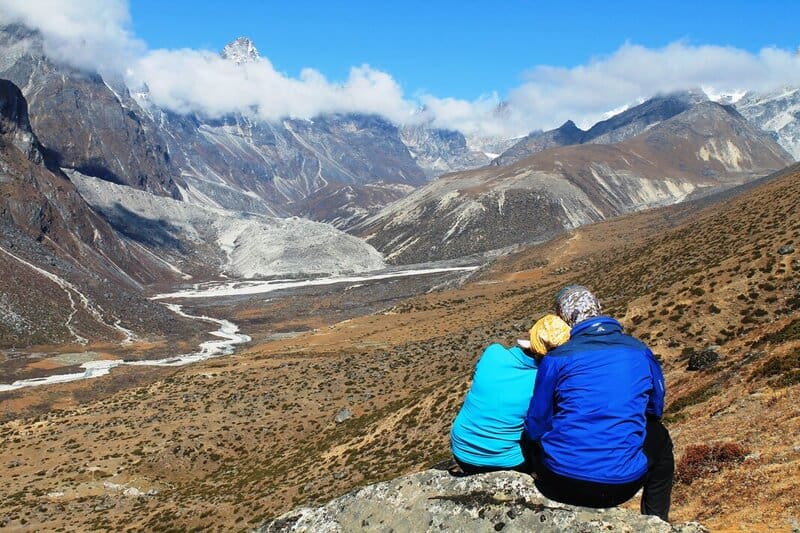
Lobuche to Gorak Shep
On the 8th day of the trek you will finally reach Mount Everest Base Camp. It’s been a long journey but you’ve made it. Now imagine if you were going to climb Everest and that was just the preparation to get to the start of the climb!
The exact location of base camp varies every year. It’s set up each climbing season by the Sherpas and is never in the exact same spot. It’s on a glacier, which is always moving.
From base camp you can see the Khumbu Icefall, the first hurdle for the climbers as they attempt to summit Everest. There is a lot of ice up here. It’s bone-chilling cold. But it’s absolutely gorgeous. And after 8 days of hiking through the Himalayas it’s a remarkable reward.

You won’t stay at base camp too long. If it’s not peak climbing season there really won’t be much there. Just some flags and a sign to take a photo with.
After you’re done with your photos you can walk around the ice a bit, just be careful. Then you’ll head back to Gorak Shep – which you passed earlier – and spend the night at 5290m (17,355 ft), most likely the highest you’ll ever sleep in your life.
And by sleep I mean not really sleep. My head was pounding so much I barely slept at Gorak Shep. We saw some people in our tea house that seriously looked like they were going to pass out and were in need of helicopter evacuation. As much as my head hurt, I knew I was doing better than many others!
Gorak Shep to Pheriche
Before starting your rapid descent back to civilization, you’ll be whisked awake before the sun rises to hike to the top of Kala Patthar. At 5550m (18,200 ft), it’s quite possibly the highest you’ll ever be on planet earth. But the amazing thing about the Himalayas is that this mountain is a baby compared to its surroundings. You’re still 3300m (10,800 ft) below Everest!
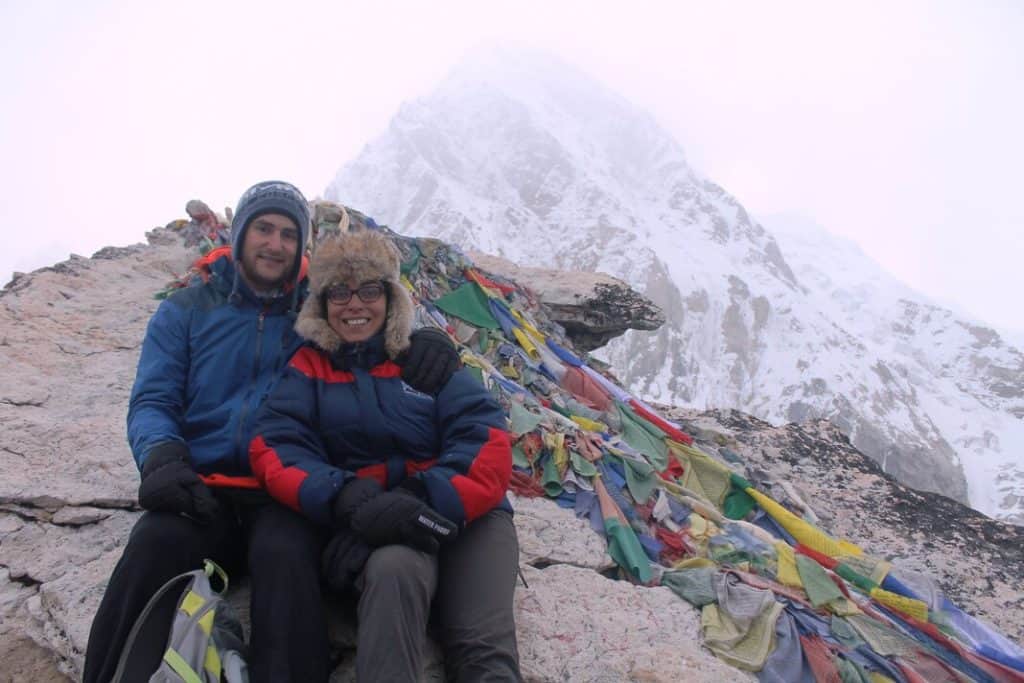
It’s very cold at the top of the mountain so be prepared. You’ll get some nice views of Everest then start your decent. After 8 days of basically hiking straight up it’s amazing to be going down. Breathing becomes easier with every step you make.
You’ll cover twice the ground you did each day going up. Periche is very close to Dingboche and you’ll have a good sleep knowing that you’re heading further down tomorrow.
Periche back to Lukla
The final two days of the trek are basically just getting back as fast as you can. You’ll spend another night in Namche Bazaar and you’ll be amazed at how quick you’re back in Lukla watching the planes land.
Don’t be fooled, though. It’s not like it’s totally downhill. There is still some up and down hiking, especially at the lower elevations. I remember the hike back up to Lukla from Phakding being particularly agonizing. Not only were we going back up, but it was damn hot!
A Farewell to the Himalayas
After a final night in the mountains you will be taken back to Kathmandu. It’s time to either continue your journey or head on home. The trek will leave you exhausted and in desperate need of a quality meal, but you will feel so rewarded that you’ll be dying to come back to the Himalayas for another trek. For me personally I’d like that next trek to be in the Ladakh region of northern India. But anywhere in the Himalayas is just magnificent.
The Beauty of the Himalayas
Nothing compares to the Himalayas. Maybe the Andes in South America, but the Himalayas are really in a league of their own. I can’t describe how beautiful it is, so below I’ve added a collection of photos that can speak for me.





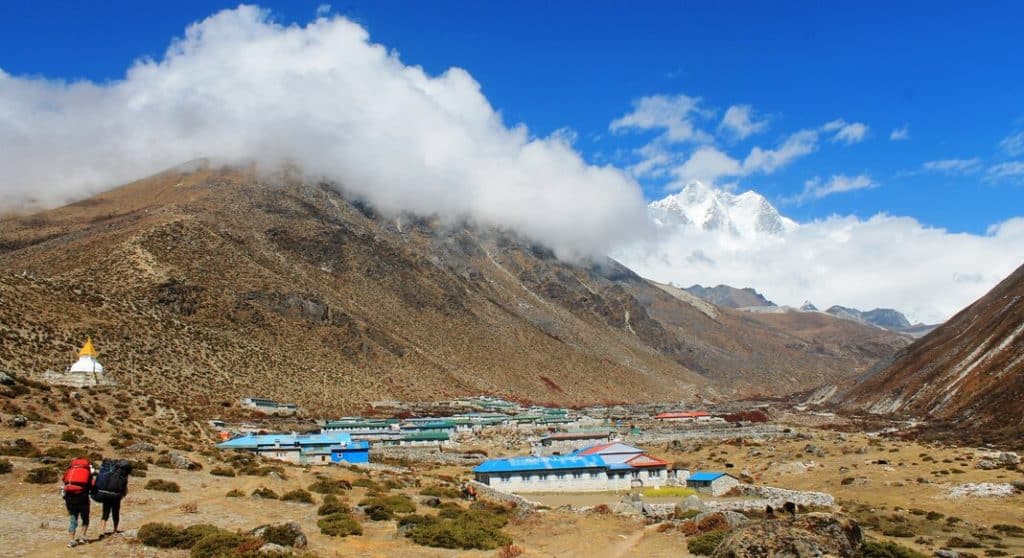
Final Word
The Everest Base Camp trek will be physically and emotionally exhausting. Your muscles will be sore and your head will hurt. But no matter how much your body might hurt, you will feel alive.
It’s an experience like none other and no one that sets out on the Everest Camp Camp trek and completes it ever regrets it. As long as you are prepared for the trip you will make unforgettable memories and long to come back.

